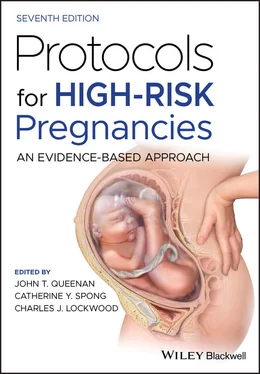Some women may experience improvement or remission with evidence‐based psychotherapy. However, some women may require pharmacotherapy. This may lead to additional concerns because the antidepressants and anxiolytics, that are often used concurrently, are linked to adverse perinatal and fetal outcomes. Researchers note an increased risk of fetal malformations although the magnitude of this risk is small and largely centered on atrial and ventricular septal defects. Moreover, such risks are only associated with certain antidepressants (e.g., paroxetine). Other worrisome associations include delivery of an infant who is preterm or small for gestational age, as well as a very small increased likelihood of persistent pulmonary hypertension. The evidence for a number of these outcomes among women treated with antidepressants in pregnancy is mixed, with the strongest support for an increased risk of preterm birth. However, even the smallest risk can lead to apprehension on the part of patients and uneasiness for their prescribing physicians.
As with many psychiatric disorders, the pathophysiology of a depressive disorder is unknown, although evidence suggests that underlying risk is determined by biology (e.g., genetic factors), stress, and trauma. Co‐occurring general medical conditions and exposure to selected medications and other substances can also lead to development of depressive symptoms or an MDE. Brain imaging studies show that individuals with depression have changes in neurocircuitry and volume reductions in critical brain areas such as anterior cingulate cortex, amygdala, and hippocampus. These regions are also affected by elevations in glucocorticoids and there are long‐standing theories that implicate dysregulation of the hypothalamic–pituitary–adrenal axis in depression. For example, the introduction of stress leads to secretion of cortisol. The integrity of the feedback systems between cortisol, adrenocorticotrophic hormone, and corticotrophin‐releasing hormone (CRH) is compromised in many individuals, with depression leading to overexpression of these hormones. Ongoing exposure to these hormones can lead to anatomic and dynamic (signaling) changes in the aforementioned brain regions.
There are several mood disorders that fall under the category of “depression” and they are outlined in the Diagnostic and Statistical Manual (DSM) version 5 (American Psychiatric Association 2013). The prototypic depressive disorder is an MDE. There are nine candidate symptoms of an MDE: depressed mood, diminished interest, significant weight change, insomnia or hypersomnia, psychomotor retardation or agitation, fatigue, feelings of guilt or worthlessness, decreased concentration, and recurrent thoughts of death or suicide. An affected woman should have at least five of these symptoms, including either depressed mood and/or diminished interest, most of the time for two weeks. If a woman has a history of manic/hypomanic episodes as well as MDEs, she suffers from bipolar disorder but is presenting in the depressed phase. Mania is characterized by elevated/expansive/irritable mood, increased energy, grandiosity, decreased need for sleep, pressured speech, and increased participation in goal‐related or risky activities. If she has never had manic or hypomanic episodes, and she meets the above criteria, then her diagnosis is unipolar major depressive disorder.
The management of a pregnant woman with an MDE will vary depending upon whether she has unipolar or bipolar illness. In either case, she may benefit from psychotherapy although she should be monitored to ensure that this treatment is sufficient for response. If she requires pharmacotherapy, she should be apprised of the risks and benefits and this should be documented in her medical chart. Along with her obstetrician, it may be prudent to have her evaluated and followed concurrently by a psychiatrist. If she experiences thoughts of self‐harm or suicide, she should be evaluated by a psychiatrist or clinical psychologist as soon as possible.
Women with MDE who suffer from bipolar disorder will require treatment with a mood stabilizer and an antidepressant. Valproate and carbamazepine are effective mood stabilizers but also established teratogens and should not be used early in pregnancy. Lamotrigine is FDA approved for treatment of individuals with bipolar disorder and may be useful although it must be titrated up slowly and it is specifically useful for bipolar depression and not bipolar mania. Lithium is the gold standard treatment for bipolar disorder but has been associated with fetal cardiac defects. It may be best to avoid this agent early in pregnancy, although the absolute risk of lithium is now considered to be lower than it was after publication of results from the lithium registry. The risk of a major malformation, including a major heart anomaly, is about 70% higher than in those who are not exposed to lithium although some investigations find no increased risk for malformations. Moreover, many of the malformations are very rare so increased risk is difficult to establish, even in large cohorts. First‐ and second‐generation antipsychotics (e.g., olanzapine, risperidone) have good mood‐stabilizing properties and appear to have lower teratogenic risk than anticonvulsants. If mood improves, there is no need to add an antidepressant.
Women with unipolar MDE who are not sufficiently treated with psychotherapy or women with bipolar disorder who did not respond to a mood stabilizer alone will need treatment with an antidepressant. The reproductive safety profile of the older tricyclic antidepressants is no better than for the newer, serotonin or serotonin‐norepinephrine reuptake inhibitors. However, older agents have more side effects. It is reasonable to start with either a selective serotonin reuptake inhibitor or bupropion. If a woman is struggling to avoid nicotine cigarettes, use of bupropion may help treat her nicotine addiction and her depression. Given data associating paroxetine use in pregnancy with malformations of the heart, many experts recommend that this agent not be prescribed to pregnant women in the first trimester. However, if a woman presents well into her first trimester of pregnancy on a particular agent, there may be little benefit to switching to a different agent since in utero exposure has already occurred. In any case, women should be counseled to minimize use of other harmful licit and illicit substances such as cigarettes, alcohol or recreational drugs. Use of such substances is more common in women with depression and patients may not realize that cigarettes, alcohol or other drugs are as harmful, if not more problematic, than antidepressant agents.
It is ideal to see a woman a week after initiation of pharmacotherapy for MDE to determine the presence and magnitude of side effects to the medication and assess further deterioration in psychiatric status. Subsequently, she can be seen again after two weeks and then monthly. Some degree of mood improvement may be noticeable within a few weeks. However, it may take 6–8 weeks to see full response to treatment. The patient should be assessed for suicidal thoughts at each visit. While some clinicians have concerns that asking about suicidal thoughts will “suggest” this action to patients, this is not the case. Appropriate emergency medical care can be arranged if the patient endorses suicidal thoughts. If the obstetrician is unable to provide follow‐up care at these intervals, the patient may be referred to a psychiatrist who can communicate with the obstetrician regarding the patient’s progress. Once response has been obtained, the patient’s mood can be reevaluated at routine obstetrics visits.
Читать дальше












